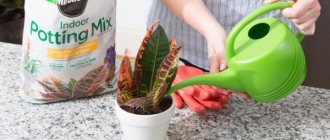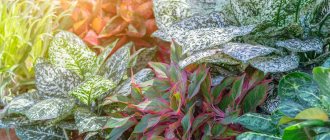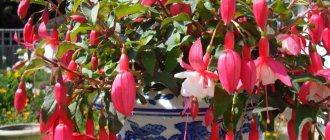2.Description - what petunia looks like
Petunias are beautiful perennial flowering herbaceous plants.
The stems are erect, hanging down in a stunning cascade in ampelous species.
The leaves are oval, sessile, 5 - 7 cm long.
The flowers are very large - up to 10 cm in diameter, funnel-shaped, with 5 fused petals, in a wide variety of colors, including two-tone ones. Currently, varieties with yellow flowers have been obtained. In many varieties, the flowers have a delicate, pleasant aroma, which intensifies at night. The buds form and open sequentially - from the base of the shoots to their tops.
Height . Depending on the variety, it ranges from 15 cm to 40 cm . In ampelous petunias, the shoot length reaches 60 - 70 cm .
How to cultivate correctly?
The best technology for growing petunias is:
- Large capacity.
- Regular feeding.
- Sufficient watering.
- Removing faded flowers.
This plant loves loamy soil, but also takes root well in ordinary garden soil , and some varieties even in simple soil. But it is best to grow this beauty in fertile soil, which consists of peat, turf, river sand, and leaf soil. Another excellent option for growing is adding nitrophoska to the earthen substrate.
In garden soil, the greenery of the plant becomes juicier and its growth accelerates, because... they really like a slightly acidic environment.
Growing petunias requires special light conditions. She prefers well-lit areas for growing, however, in the scorching sun, flowering may fade. Small shading is also needed.
Lighting is one of the main conditions for growing petunias. Therefore, well-lit, shaded areas are ideal.
The soil in which petunia grows should be moist, but not flooded. Excess moisture will stop its growth. It is also important to ventilate the soil in which the plant grows. Growing these flowers is not difficult if you simply follow the conditions of lighting, watering and soil composition.
3. Petunia propagation - growing from seeds, cuttings
Seeds sown in spring in loose nutritious soil. You can sow even at the end of winter, but the seedlings will lack light and become elongated and ugly.
For sowing, you can use your own collected seeds . Seed collection is carried out in calm and fine weather.
Ripe seeds are located in dried, brownish seed pods that open easily when touched.
The planting material retains fairly good germination for about 4 years - after that it sharply decreases.
Remember that plants grown from their own seeds often will not inherit the attractive varietal characteristics of the mother bushes.
↑ Up,
Since petunias require long daylight hours for good development, during winter sowing it is necessary to organize artificial lighting with fluorescent or phytolamps.
- To plant, take a plastic container with a lid and place a small drainage layer in the form of fine expanded clay on its bottom.
- A layer of substrate based on peat and river sand with a loose consistency and a sufficient supply of nutrients is poured onto the drainage.
- A small portion of the soil mixture, sifted through a sieve, is poured on top of the soil - it will be loose and it will be easy to allow not only moisture, but also air to reach the plants.
↑ Up, - The substrate for sowing is thoroughly moistened in advance with water at room temperature from a fine spray bottle.
- Sowing is carried out on the surface of the soil, and since the petunia seeds are too small, to distribute them evenly, use a toothpick or mix the seeds with an equal amount of river sand. Of course, it is more convenient to sow pelleted planting material, which can be purchased at a flower shop, but at the slightest drying of the substrate, the germination of such seeds comes to naught.
- For good germination, seeds need light, but not direct sunlight.
- After sowing, the soil is sprayed again and the crops are covered with a transparent plastic cap or glass on top to create a greenhouse effect and maintain a high level of air humidity.
- The seedlings are placed in a well-lit, but shaded place from direct sunlight at a temperature of 22 - 25 degrees Celsius. Seed germination increases when using bottom heating.
↑ Up,
If agricultural techniques are followed, the first shoots should appear after just a week .
Small sprouts should be ventilated daily by lifting the cap and removing condensation from it. If young plants are covered with glass, then it is simply turned the other side.
Gradually, the ventilation time is increased, and with the appearance of the first true leaf, it is removed altogether.
To prevent fungal diseases, at this time the plants are sprinkled with a very thin layer of river sand - it will facilitate better outflow of moisture from the plants after watering.
↑ Up,
Diving is carried out on flowers that already boast 3 - 4 true leaves.
Before diving, the soil is thoroughly moistened and the small sprouts are very carefully transferred into small individual cups, trying not to disturb their delicate root system.
After diving, cups with bushes can be covered for 2 - 3 days with a small piece of non-woven covering material .
↑ Up,
In the first months of life, it is necessary to especially carefully monitor soil moisture and spray the flowers in a timely manner, keeping the soil evenly moist, but not waterlogged.
The first fertilizing with mineral fertilizers with a high nitrogen content should be carried out 10 - 14 days after the dive . For fertilizing, a very weak solution of fertilizers is used, which is applied both directly to the soil during watering and sprayed onto the leaf blades.
The first buds on plants grown from seeds will appear 2.5 - 3 months after the sprouts appear.
↑ Up,
Sowing seeds in snow gives very good results - to do this, collect a small amount of snow and spread it over the surface of the substrate in a container.
The brown seeds will stand out well against the white background and can be spaced evenly. Gradually melting snow will further moisten the crops.
↑ Up,
Sowing seeds can be done in peat tablets - despite their cost, they have proven themselves very well when growing petunia.
Bushes planted in peat tablets do not need to be pricked - seedlings grown in this way can be immediately planted in a permanent place along with the tablet.
↑ Up,
If small bushes stand still for 1 - 2 weeks and show no signs of growth, then there is no need to worry - at this time the roots are simply actively growing .
↑ Up,
Terry and ampel varieties , as well as calibrachoa are propagated by stem cuttings 8 - 10 cm long with 3 - 4 3 - 5 internodes.
The most successful period for rooting is considered to be the end of winter - beginning of spring . When cuttings at other times of the year, plants must be provided with artificial lighting.
- The cuttings are separated from the mother plants using sharp, sterile pruning shears or scissors and all leaves except the top pair are removed.
- To reduce moisture loss, the remaining leaf blades are cut to half their length.
- The bases of the cuttings are dusted with rooting powders.
- Immerse the cuttings in a nutritious, loose, and well-moistened peat-based substrate. As a top layer, you can sprinkle the cuttings with sand or perlite to drain water.
- The top of the cuttings is covered with glass or transparent plastic film and, instead of watering, they are sprayed with a fine sprayer.
- Place the cuttings in a place shaded from sunlight with a temperature of 22 - 25 ° C.
- Every day the cover is removed and the condensation that appears on it is wiped off.
↑ Up,
After 1 - 2 weeks, new leaves and shoots will begin to appear on the cuttings, which means that the rooting process has been successfully completed - at this time the cover can be removed.
A month after new growth appears, the plants can be planted in small pots, pinching off all the stems, leaving 4 to 5 leaves on each.
Repeated diving into slightly larger containers is carried out after another 3 - 4 weeks.
↑ Up,
How to save petunia until next spring. Ways to Preserve Flowers
To preserve petunia until spring, several methods are used. You can put the adult plant in a warm place or use the cutting method.
By transplantation
For replanting, mother plants are used, that is, an adult petunia bush, which is left until spring, followed by cuttings. To do this, the bush is transplanted into a potted container at the end of September or beginning of October. At the same time, it is taken into account that the plantings must have time to take root before the onset of cold weather.
An important condition for transplanting a queen cell into a pot is the selection of a container. The pot is selected taking into account the size of the adult plant and the volume of its root system.
Information! Petunias are characterized by the growth of lateral root appendages, so small containers are not suitable for replanting.
After transplantation, dry or damaged parts are removed from the mother plant, leaving only 10 centimeters from the entire stem. After this, the mother liquor must be transferred to where it is dry and cool.
Using cuttings
Gardeners call cuttings, which do not depend on the time of year, an advantage of petunias. Experts recommend carrying out a planned cutting procedure in the fall, at which time the flower is completely ready for propagation:
Cuttings are carried out following the sequence of actions:
- Cut off the upper branches, on which there are four or six leaves.
- The flower is cut from the top.
- Then the bottom sheets are cut off.
- The cut of the stem is released into a root former or root growth stimulator (a solution of manganese or crushed activated carbon is used for the same purpose - such a procedure disinfects the plant and promotes its rapid development).
- Then the cuttings are placed in a soil mixture for which different soils are used.
- The plants are watered and the soil is lightly compacted.
- Cover with a transparent lid or film.
Creating a greenhouse effect with the help of additional shelter helps the shoots to take root faster due to constant moisture.
4.Petunia - planting and care
4.1.Growing in open ground
Petunia is planted outside using seedlings - in the second half of May , when the threat of returning spring frosts has passed.
Before planting, seedlings must be hardened off - they are accustomed to new living conditions by taking containers with flowers outside during the daytime. Gradually, the time spent in the fresh air is increased.
For planting, prepare a well-lit place - dig up the soil and remove weeds. When grown in partial shade, flowering will be less abundant. The area should be protected from strong gusts of wind that could damage the delicate shoots of the flower. Wetlands are not suitable for growing petunias.
Nutrient-poor lands are improved by adding humus and leaf humus. To loosen and improve drainage, coarse river sand is mixed into the soil.
↑ Up,
Prepare planting holes , maintaining a distance between them depending on the planting pattern and plant variety - about 30 - 40 cm.
You should not choose a sunny and hot day for planting - the plants will acclimatize better in cloudy and warm weather.
Before planting, the bushes are thoroughly watered with warm water so that the soil becomes soft and moves away from the walls of the cups more easily.
Plants are moved by transshipment - if possible, keeping a whole lump of earth near the root system. Flowers transplanted in this way will begin to grow and bloom faster.
Plants are placed at the bottom of the planting holes and sprinkled with earth in a circle, lightly compacting it to remove air pockets. After transplanting, the flowers are watered with plenty of water.
↑ Up,
To inhibit the growth of weeds, the bases of plants are mulched with sawdust or straw .
In the first month after planting, small bushes should be watered regularly; in the future, the plants will tolerate short dry periods.
Since petunia blooms very profusely and for a long time, it will need timely feeding . They begin to feed the flowers a week after planting with fertilizers high in potassium and phosphorus. Fertilizing with mineral fertilizers is carried out every ten days , introducing a nutrient solution into the moist soil.
↑ Up,
In order for air to flow to the roots of the plants, the soil under the bushes is loosened to a shallow depth .
4.2.Wintering of petunia
Petunia does not tolerate wintering in open ground and in the autumn months it is transplanted into pots , almost all the green mass is cut off, leaving stems about 12 - 15 cm long and moved to a room with a temperature of 12 - 14 ° C.
↑ Up,
4.3.When it blooms
Petunia is one of the longest and most profusely flowering plants. It blooms with large, funnel-shaped flowers from spring, all summer and until late autumn .
When grown in open ground, flowering is often interrupted only by frost.
When and how does it bloom
Different types and varieties of petunias bloom differently and differ in the shape and size of the flowers.
Petunia blossom
Types of flowers
All varieties of plants are divided into multi-flowered and large-flowered, each type has its own characteristics:
- Multi-flowered plants consist of a large number of buds on 1 bush, which grow densely. The diameter of the flower does not exceed 4-5 cm;
- Large-flowered varieties are more vulnerable and do not tolerate rain and strong winds. They grow best in hanging pots and baskets under cover. Flowers grow up to 8-14 cm.
Flower shapes
Petunia flowers are single, round, funnel-shaped. The edges of the petals can be smooth or fringed. The corolla of the flower has the appearance of fused petals, often symmetrical or star-shaped. A separate type of petunia is double; these flowers consist of a large number of petals and look like roses.
Double flowers
Flowering period
The petunia flowering season begins in summer and lasts until early autumn. In warm regions where there is sufficient sunlight, flowering can continue until late autumn.
Changes in care during the flowering period
During the flowering season, petunia does not require special conditions. It is enough to care for it as before: moisten the soil in time, irrigate the leaves with water from a spray bottle and feed it every 14 days.
5.Keeping domestic petunia
5.1.Watering
Water generously during the growing season —soak the substrate thoroughly when watering, but allow the top layer to dry out slightly between waterings during the spring and summer.
Reduce watering in winter , when the growth of petunia has slowed down - when keeping it cool, you should simply protect the substrate from drying out completely.
The frequency of watering will depend not only on the temperature of the plant’s maintenance and development, but also on its variety. As a general rule, petunias with large buds will consume more moisture than small-flowered varieties.
For irrigation, use water at room temperature , which has been standing for a day or more. You can also water petunias with filtered or melt water, as well as rain moisture collected away from city roofs.
After watering, be sure to drain the excess moisture that appears in the pan.
When watering, water should not get on the buds and flowers - the drops may cause unsightly brown spots to appear on them - water the plants from a watering can with a thin spout along the edge of the pot.
Use bottom watering by immersing the plant pot in a container of warm water for a few minutes.
a little lemon juice to the water for irrigation - this will help maintain the necessary acidic pH of the soil.
↑ Up,
5.2.Growing temperature
Petunias prefer warm conditions at 18 - 25 ° C. This subtropical plant does not tolerate cold , the minimum permissible temperature during the winter dormant period is about 12 ° C.
During the dormant period at 10° C, the plant can shed its leaves; with the onset of even short frosts, the plants die. A cool winter causes plants to slow down and even stop their development and allows them to conserve strength for subsequent flowering in the new season.
↑ Up,
5.3.Keeping indoor petunia at home - how to pinch
Provide this tropical evergreen with warmth, humidity and plenty of sunlight .
When kept outside during warm periods, the plant produces more flowers. Place the bushes under protection from strong winds, direct sunlight and heavy rainfall. Return the plant to a warm room when the overnight temperature drops below 10°C .
Petunia requires winter dormancy , when growth stops during the winter. Stop fertilizing and water sparingly in winter, but never allow the soil to dry out completely.
At the end of winter - in February, the flowers are placed on well-lit windowsills and begin to be watered little by little.
↑ Up,
Petunia needs constant pinching of the tips of young shoots . The first pinching of seedlings is carried out when 5 - 6 leaves are formed on it - the stem is pinched, leaving 4 leaf blades on it.
If you want to control the size of the plant, trim the stems after flowering about half their length . Remove faded flowers promptly to extend flowering time.
↑ Up,
Avoid placing plants near heating systems in the winter months or under air conditioners in the summer.
Move pots to another room when ventilating the room in winter.
To maintain an attractive appearance and to form more and more new buds, fading flowers must be pinched . Petunias will not waste their energy on producing seeds and will be able to concentrate on flowering.
Remember that petunia does not like any sudden changes in living conditions - accustom the plants to any changes gradually.
↑ Up,
5.4.What and how to feed petunia
Plants kept in pots have a limited feeding area and need timely feeding .
Every 2 weeks, the bushes are fed from spring to autumn with liquid mineral fertilizer with a high content of phosphorus and potassium, diluted by half.
Petunia does not really like fertilizing with organic matter, because it contributes to the development of fungal diseases. Organic fertilizers can be used approximately every month ; humus, well-rotted cow or horse manure, and a weak solution of chicken manure are used as organic matter.
↑ Up,
In the fall, when flowering subsides, the frequency of fertilizing is gradually reduced and the plants are transferred to a dormant period, which will last until spring.
Resume fertilizing only when the first signs of new growth appear in the next season.
Apply the nutrient solution only after abundant watering - into a moist substrate, since the ingress of fertilizers onto the root system in dry soil can cause a chemical burn .
↑ Up,
5.5.Transplant
Petunia is often grown as an annual plant and does not need replanting.
If you decide to save the bush for the second year, transplant it into a larger pot in the spring
The best time for replanting is considered to be the period when young leaves have already begun to appear on the bushes, but buds have not yet formed.
Use pots with large drainage holes to prevent water from pooling at the root system.
↑ Up,
- Before planting, place a sufficient drainage layer in the form of expanded clay, broken brick or river pebbles on the bottom of the pots.
- Sprinkle the drainage with a small layer of soil.
- Place the flower in the center of the pot, preferably along with a lump of soil, and add fresh soil to the container.
- After replanting, water the plants generously and, if necessary, if the soil has subsided, add fresh soil.
- Transplanted plants should not be exposed to direct sunlight for 7 - 10 days, and should not be fed for 10 - 14 days.
↑ Up,
5.6.Lighting
A sunny window or a balcony filled with light is suitable for growing petunias. Provide petunias with at least 4 hours of direct sunlight every day . In the shade the plant blooms reluctantly.
Light shading will be necessary for the flower only during the hottest hours of the day - protect the petunia from the sun at this time with a tulle curtain.
The most suitable for growing at home will be window sills facing east or west .
↑ Up,
When kept on the south side, use shading or move the plants slightly deeper into the room.
If there is a lack of natural light, you can use artificial lighting in the form of fluorescent or phytolamps.
In order for plants to look healthy and bloom profusely, the duration of daylight should be at least 11 hours .
↑ Up,
5.7.Soil
porous, well-drained substrate is suitable for growing petunia .
The mixture can be made up of components as turf and leaf humus, peat and coarse sand.
The flower tolerates soils that are quite poor in nutrients .
The substrate for growing petunia should have a neutral or slightly acidic pH .
↑ Up,
5.8.Spraying
Air humidity is from moderate to high.
Place the pot on a tray of damp gravel or use a humidifier to increase the humidity around the plant.
It is not recommended to spray petunia - drops of moisture falling on the flowers can ruin their attractive appearance, and the pubescent leaf blades of many varieties will rot from water.
Petunia should be kept in a well-ventilated area with sufficient air circulation, but without exposure to cold drafts.
↑ Up,
↑ Up,
Replanting indoor petunias, picking
One of the frequently asked questions is “can I grow petunia as a houseplant?” The flower feels best outdoors; it can grow in the garden or on the balcony. The plant is grown at home for further planting in a permanent place. Before this, a pick is carried out - a preliminary transplant into a temporary pot.
Petunias peak when the shoots develop foliage. How to do it correctly:
- Prepare soil for petunias, pour it into plastic transparent glasses 1/2 full;
- The sprouts are dug up together with a lump of earth so as not to damage the roots, and placed in a glass;
- The cups must be filled to the top with soil.
In about 30 days, the sprouts will form a root system and grow slowly. After 40-50 days, active growth begins; intertwined roots will be visible in a transparent glass. At this point, the petunia needs to be transplanted into a 2-3 liter pot.
7.Purpose
A spectacular ornamental flowering plant that is used in landscaping parks and squares. Ideal for growing on balconies and terraces .
Hanging varieties are very attractive in hanging baskets. A bright beauty, petunia will decorate any flower bed or flower bed in the garden, and its long and abundant flowering has rightly made it very popular among gardeners.
↑ Up,
Is it possible to grow petunia at home? Who will stop us?!
Most often, elegant flowers can be seen in private gardens and decorative flowerpots in urban landscaping. However, the flower is so good that it makes sense to keep it on your windowsill - the whole family will enjoy it.
This plant is a legend:
- it was first described by the evolutionist Jean Baptiste Lamarck;
- an asteroid was named after him;
- it has become a favorite subject for geneticists to study hybridization.
And this legend, at your request, moves into the apartment.
9.Varieties of petunia:
The classification of petunias is quite complex and varied. For example, depending on the type, plants are divided into bush , cascading and hanging . Bush ones form low bushes up to 70 cm, ampelous ones form long drooping shoots and are grown in hanging pots, cascading ones have shorter and thicker, curly stems and can be grown not only in a hanging basket, but also around a support.
Based on the type and size of flowers, they are distinguished:
Large-flowered petunias - grandiflora - are distinguished by a wide variety of colors and, of course, a large diameter of flowers; the plants form medium-sized bushes. Small-flowered or millifora - distinguished by the small size of funnel-shaped flowers and their very abundant formation, forming compact bushes. Terry - plants with more petals than simple varieties. Fringed varieties - petunias fimbriata - flower petals have lush, corrugated, torn edges. Frillitunias are plants with large flowers, the edges of the petals are wavy curved. multifloral petunias or multiflora. Pikoti are plants that produce flowers with an attractive thin white border around the edge of the petals. Supertunias are varieties with an ampelous growth type, with long drooping shoots, abundantly covered with flowers.
↑ Up,
9.1.Large-flowered petunia - Petunia Grandiflora
9.2.Hybrid petunia - Petunia hybrida
A small herbaceous annual up to 30 cm high with green, sessile, ovate leaves that emit an unpleasant odor when damaged. The leaves can be arranged either oppositely or alternately. Flowers appear throughout the summer months and remain on the plants until frost. Shades of funnel-shaped flowers range from violet, purple, red, pink, blue, yellow or white. There are plants with two-color buds.
↑ Up,
9.3.Petunia “Night Sky” - Petunia “Night Sky”
Incredibly beautiful bush petunias up to 25 cm high with delicate pubescent shoots and oval, light green, sessile leaves. The main varietal feature is the color of small funnel-shaped flowers - when the main dark blue or lavender tone is chaotically scattered with white or pink specks of varying sizes, reminiscent of stars in the sky. The color of each flower is unique.
↑ Up,
9.4.Petunia “Easy Wave” - Petunia “Easy Wave”
Compact plants up to 25 cm high with lodging stems, often used as ground cover. The flowers are simple, funnel-shaped, simple, with velvety petals. Flower colors include white, purple, lilac with dark veins, burgundy, red, pink, yellow, and blue.
↑ Up,
9.5. Petunia Tidal
Tall herbaceous plants belonging to the large-flowered type. They grow quickly and have erect stems up to 90 cm high, on which are sessile green leaves and simple funnel-shaped flowers. Flowering is very abundant in shades of cherry, hot pink, purple, and white.
↑ Up,
9.6.Petunia Sophistica - Petunia Sophistica
Small hybrid petunias up to 35 cm high with large, green, sessile leaves and simple funnel-shaped flowers. A distinctive feature of the plants in this collection is the unusual color of the flowers - they can have pink, lilac, dark burgundy, almost black and light green shades.
↑ Up,
9.7.Petunia Dreams - Petunia Dreams
Small bush petunias up to 40 cm high with abundantly branching stems, small, oblong, green leaves. The flowers are large, reaching a diameter of 10 cm, simple, funnel-shaped, in shades of white, pink, crimson, red, purple. Often there are plants with a white border along the edge of the petals - picoti.
↑ Up,
9.8.Petunia Velvet
This includes both supertunias - ampel-type plants with very long and flexible shoots, and bush petunias. Flowers can be single or double; the main feature of this line is the delicate velvety petals.
↑ Up,
9.9.Petunia Picobella - Petunia Picobella
Annual bush small-flowered compact petunias with branched stems up to 25 cm high. Plants form small, simple, funnel-shaped flowers in shades of white, lilac, blue, pink, crimson. Flowering is very abundant.
↑ Up,
9.10.Petunia “Daddy” - Petunia Daddy
Large-flowered bush petunia up to 40 cm high with delicate green shoots and oblong leaves. The main feature of the variety are large, funnel-shaped, simple flowers, often with a very pleasant aroma and colored in pink, purple or lilac tones. The flower petals have thin, branching dark veins. Purple flowers have the strongest aroma.
↑ Up,
9.11.Petunia Ultra - Petunia Ultra
A large-flowered bush petunia with simple, funnel-shaped flowers with bicolor petals in shades of white, crimson and purple. The variety has very early flowering.
↑ Up,
9.12.Petunia Salmon - Petunia Salmon
Hybrid ampelous petunia with long, branching, drooping stems up to 1 m long and sessile, light green leaves with slight pubescence. It belongs to the large-flowered type - it has large funnel-shaped flowers of a soft pink hue.
↑ Up,
9.13.Petunia Aladdin - Petunia Aladdin
Compact herbaceous annual up to 30 cm high with abundantly branching shoots. The flowers are simple, 7 - 8 cm in diameter, white, pink, purple, salmon, burgundy.
↑ Up,
9.14. Petunia Pirouette
Compact bush petunias, fringed, double, picoti. The stems are strong, branched, with sessile, oval, green leaves. Flowers with many ruffled petals with ragged edges resemble pompoms on children's hats.
↑ Up,
9.15.Petunia Bravo - Petunia Bravo
Large-flowered bush petunia with simple funnel-shaped flowers. It is a fairly compact plant, reaching 30 cm in height. The flowers are white, purple, pink, crimson - they can be either plain or with pronounced dark veins on the petals.
↑ Up,
Possible problems in growing petunia
Having figured out how to grow petunia from seeds or cuttings, you need to be prepared for possible problems.
spoiled plant
A spoiled plant is easy to recognize; its stems are weakened, the leaves become dull or turn yellow. Fungal diseases or pest damage are always clearly visible.
Diseases
Failure to comply with watering rules and dense planting provoke the formation of a “black leg” in petunia seedlings. How to fix the problem:
- Remove the diseased plant along with the roots and soil around it;
- The remaining plants must be treated with a fungicide;
- Set up a watering schedule and avoid stagnation of moisture.
Plants can be susceptible to fungal diseases, the most common disease being powdery mildew. The reason for its appearance is temperature changes and increased soil moisture. Damaged areas of petunia must be removed, the rest are treated with sulfur compounds.
Pests
Petunias are exposed to the following pests:
- The spider mite is a small spider that starts among the foliage and envelops it in a web. Spraying with sulfur compounds, water and tobacco solution will help get rid of it;
- Whiteflies are small white butterflies. To get rid of them, you need to treat the leaves with soap or tobacco solution, insecticides;
- Aphids are pests the size of a dot. The lower part of the leaf is affected, after which the leaves curl. You can get rid of aphids using a soap-soda solution or chemicals.
Other problems
Other problems include yellowed leaves and weak stems that cause the plant to fall over. These problems are associated with improper transplantation and care. Perhaps the plant is planted in unsuitable soil, or it lacks fertilizing and light.
Among the variety of garden flowers, petunia is the most popular; growing from seeds at home and further care require serious attention. The plant needs to be watered, pruned and protected from pests on time in order to obtain beautiful flowering.
Problems, diseases and pests
Sometimes you may encounter a problem such as yellowing or drying of petunias. If you do not follow the rules of care, the plant may get sick:
- late blight;
- chlorosis;
- black leg;
- gray rot.
They need to be dealt with with special drugs. But it’s easier to prevent their appearance with proper care. If these rules are not followed, then in addition to these diseases, petunia can be affected by viral diseases. There is no cure for them - your plant will die. Among the dangerous pests are spider mites, aphids, slugs and thrips.
For abundant and long-lasting flowering, it is necessary to regularly feed and prune the plant. We recommend reading our articles on how to care for petunia during flowering and how to preserve it in winter.
Follow simple rules for caring for petunias, then you won’t have to worry about the health and beauty of your plant. It will always delight you with beautiful blooms.
Conditions for growing seedlings
Petunia seeds germinate only at a temperature of +24-25 °C. Hybrid varieties that are particularly sensitive to temperature. If the temperature is below normal, the grains simply will not sprout, and at higher temperatures, young plants will begin to stretch out and get sick.
Seeds germinate on the sixth or seventh day after germination, if they are provided with temperature conditions and proper lighting.
After germination, seedlings need regular ventilation twice a day. First, the film is removed for 20 minutes, on the second day - 40. Every day the time is increased, and the temperature is reduced to + 20 ° C during the day, and to + 16 ° C at night. This will prevent the sprouts from stretching too much.
The first days after germination, the plant’s root system actively develops. Shoots and leaves will begin to grow much later.
Pruning at home
Garden shears - the best pruning tool
A few weeks before flowering begins, the first pruning of the flower bush is carried out. This procedure is necessary to maintain the splendor of the plant. First, the ends of the shoots are cut off. Then, during the procedure, all dried leaves and shoots on which flower buds do not form are removed.
Repeated pruning is needed after the petunia has bloomed. You need to cut off and collect all the dried buds. This is done so that new seeds do not have time to ripen in them.
Important! Pruning must be carried out with a sharp and disinfected instrument. Garden shears are best suited for such work.
Varieties and types of petunia
According to the latest estimates by flower growers, the number of petunia varieties totals more than five hundred specimens. Even an experienced person can easily get lost in this diversity. To describe all the varieties and types of this flower, to note the advantages and disadvantages, one article is not enough. Therefore, we note the main points. All petunias are divided by type, flower shape and color.
Cascading petunias are used to create compositions on balconies, loggias and gazebos. This species produces numerous long shoots that grow in different directions. The series comes in a variety of shades and is suitable for moderate continental climates. The most popular varieties are Ramblin, Typhoon and Rose.
You need to know this! Calibrachoa and petunia were considered the same flower until 1990, when it was proven that they have a different set of chromosomes. In garden centers, calibrachoa varieties are still sold under the names “ampel petunia” or “surfinia”. Be careful! Care for these plants varies.
Ampelous petunias are planted in pots, cache-pots, boxes and containers. They decorate gazebos, trees, hanging flowerpots. The peculiarity of this species is its long shoots that go down only, resulting in the formation of beautiful flower waterfalls. Also, hanging varieties can be planted on alpine hills or the banks of artificial reservoirs. The best varieties are “Surfinia”, “Wave of Luck”, “Pearl Surf”, “Waterfall”.
Bush petunia tolerates care and growing at home well. This type is distinguished by its compact shape, variety of color shades and decorative patterns. The formation of the shape is arbitrary and depends on the frequency of pinching the shoots.
Bush petunia grows equally well in an apartment and on a summer cottage, on a balcony and a flower bed. Popular subgroups: “Milliflora”, “Multiflora”, “Grandiflora”. Varieties that deserve attention are “Grandiflora Triumph”, “Fantasy”, “Storm”, “Parade” series.
In conclusion, it is worth noting completely new varieties of petunias that have been recently developed.
- Petunia Picobella is a cold-resistant, semi-ampeloid plant that blooms profusely with small flowers.
- Petunia Limbaugh is interesting with a new shade of burgundy. The Duve and Ivy series are distinguished by durability and increased resistance to cold.
Interesting! In 1921, asteroid number 968 was discovered and given the name Petunia.
Petunia is a magnificent plant, easy to care for and grow in an apartment, country house and garden. Both an experienced professional and a novice amateur gardener can handle it. It can delight for a long time with its bright colors, bring practical benefits and provide aesthetic pleasure.
When to sow petunia for seedlings
It is better to start sowing petunia seeds for seedlings in the first ten days of March - petunia is light-loving, February seedlings stretch out and quickly outgrow. The most authoritative flower grower FORUMHOUSE with the nickname Lobelia recommends:
- If it is possible to keep the seedlings in April - May on a glassed-in loggia or balcony, then it is better to start sowing in the first ten days of March .
- You don’t have to bother with removal, removal, shelter and start sowing petunias on the 20th of March and planting the grown seedlings directly into the garden.
LobeliaFORUMHOUSE member
These are approximate sowing dates based on personal experience, capabilities, and techniques for caring for seedlings. Much depends on the germination of the seeds themselves.
From sowing the seeds to planting petunia seedlings in the ground, 10-12 weeks should pass, based on this, it is necessary to plant petunia seedlings. But petunia grows very quickly, so it’s better to be a little late than to hurry.
Benefits of preserving petunias in winter (cuttings or mature plants)
The main advantages of preserving petunias for the winter:
- early spring flowering. An adult “second-year” plant or cuttings taken from it can bloom as early as February-March. And this will happen even in the northern regions, such as the Urals, Siberia, etc.
- ease of obtaining adult seedlings. To do this, you do not need to sow small seeds or nurse frail shoots. The planted cuttings will already bloom in 2-2.5 weeks.
- preservation of vegetatively propagated petunia varieties until spring.
Read also: How to properly grow basil in open ground
Option #2. Preserving petunia in winter by cuttings
Maintaining petunia queen cells in winter requires special conditions - high humidity and low temperatures. In a city apartment, with an unglazed (or glazed, but cold northern) balcony, it is almost impossible to recreate such a climate.
In residential premises, rooted cuttings, rather than adult petunias, have a better chance of survival. They do not need special conditions and need to be cared for in the same way as indoor flowers. This method will also help those gardeners who do not want to clutter their verandas, balconies and loggias in winter with large containers with petunia queen cells. Cuttings in cups on windowsills take up very little space!
For winter storage, petunia is cut from late August-September. During this time, petunia propagates easily by cuttings, since the life processes in it have not yet slowed down. 5-10 days after planting, the plants begin to develop roots.
Cuttings 5-10 cm long are cut from petunias, planted in cups, and covered with a “greenhouse”. After rooting, they are placed in a cool, bright place. For example, on a windowsill, closer to the glass. To increase the humidity, you can place a jar of water near young petunias.
Young petunia cuttings require as much attention in winter as ordinary indoor flowers.
The main conditions for keeping rooted petunia cuttings in winter:
- sufficient watering - after drying the top layer of soil;
- spraying;
- lack of fertilizers;
- increasing air humidity (water containers next to the cuttings).
In spring, cuttings that have already formed into young petunia bushes can be transferred to balcony containers or planted in a flower bed. They can also be cut again and the required amount of planting material can be grown from the new cuttings.
Overwintered cuttings bloom already with the first rays of the warm sun - in February or early March
Caring for petunia and creating conditions for lush flowering
When the seedlings get stronger, caring for them becomes much easier. Petunia is an unpretentious plant that requires a minimum of attention. How to care for petunia so that its flowering continues until autumn? It is enough to create favorable conditions for her, adhering to several rules.
- Lighting. Petunia is a light-loving crop. During the active growing season, it is placed on western and eastern windows. The south side must be shaded. North-facing windows can only be kept with additional artificial lighting. Signs of a lack of light - the shoots become longer, thinner, and the leaves turn pale.
- Temperature . Loves moderate heat 20–25 ˚С. Easily withstands heat up to 30˚C. At home, petunia does not bloom at temperatures below 19˚C. In winter, a period of rest at a temperature of 10–18 °C is desirable.
- Humidity . Petunia is neutral to the level of air humidity, but responds gratefully to spraying. In winter, additional moisture is not needed - they are sprayed mainly in summer.
- Watering. It is important to water petunia properly as it is susceptible to rot and fungal diseases. It is undesirable to flood or overdry the soil - you need to try to find a middle ground.
- Feeding. Petunia begins to be fed two weeks after the last picking. Potash fertilizers are applied every ten days. Sometimes you can feed with organic, humic mixtures.
Read also: What flowers can be grown without sunlight
Seed selection
The most important requirement for seed material is that it must be fresh. One of the main difficulties that a gardener may encounter is a low germination rate.
When choosing seeds, you should give preference to products from trusted manufacturers. Coated seeds must be sprouted in high-moisture soil to dissolve the coating.
When purchasing regular seeds, you should ask the seller about the conditions and shelf life.
Features of care during the dormant period, in winter
People who are going to seriously start breeding petunia should understand the nuances of caring for it during the dormant period. You need to care for flower bushes in winter, observing the following conditions:
- Reduced watering. In winter, watering should be done infrequently - 3-4 times a month.
- Lack of fertilizing. In winter, petunia does not need fertilizer and therefore does not need to be fed.
- Maintaining optimal temperature. In winter, the flower can be grown at a temperature of 8-10 degrees Celsius.
Petunia on the balcony
From the beginning of summer until mid-autumn, the balconies of flower lovers are decorated with magnificent colorful bouquets. Anyone who is willing to put a minimum of effort into it can grow petunia on the balcony: the plant is unpretentious, but certain rules must be followed when growing it.
Is it possible to grow petunia at home? Who will stop us?!
Most often, elegant flowers can be seen in private gardens and decorative flowerpots in urban landscaping. However, the flower is so good that it is important to keep it on your windowsill - the whole family will enjoy it.
- it was first described by the evolutionist Jean Baptiste Lamarck;
- an asteroid was named after him;
- he became a favorite subject for geneticists to study hybridization.
And this legend, at your request, settles in the apartment.
Petunia at home - how to grow from seed
The paint is grown from seeds or cuttings. You can also purchase ready-made seedlings, but it will be more expensive.
Starting from mid-March, the seeds are forced out in order to plant the flower in the open soil in June. However, petunia on a balcony and loggia will grow in a relatively regulated microclimate, and therefore, planting can begin much earlier - from the end of January.
The seeds are incredibly small, which is why they are often sold in a coated coating. Their survival rate is better, as their defense against diseases and mechanical damage increases. Planting such seeds is also much more convenient. They germinate in just 4-6 days, depending on the room temperature.
The advantage of seeds without shells is their cost. They cost much less, but take longer to germinate - approximately 2 weeks.
Priming
Neutral and slightly acidic soils are ideal for flowerpots, while alkaline and strongly acidic soils should be avoided. Ready-made store-bought soil mixtures are chosen to be loose, so that during watering the water is simply absorbed, but does not stagnate, but flows freely.
To grow a flower at home, the soil mixture can be prepared independently. To do this you need to take:
- 2 cups turf soil;
- 2 cups of completely decomposed peat;
- 2 cups of rotted humus;
- 1 cup sand.
For perfect consistency, it is not enough to simply mix all the components - you need to sift the mixture through a large sieve. Next, drainage is poured onto the bottom of the planting box - small or crushed expanded clay. Two-thirds of the sifted earth is laid on top of the expanded clay. The remaining third is sifted through a fine sieve and poured on top.
The height of the planting boxes must be at least 10 centimeters, and the volume of soil must be such that there is about 2-6 centimeters left to the edges of the box. This free space will protect the germinating seeds from the movement of cold air during ventilation.
How to plant seeds
Now the soil needs to be moistened and the seeds scattered over the surface, preferably in rows. The seeds are not sprinkled with soil on top, as they require light to germinate. It is enough to sprinkle them with a little water from a spray bottle and press down each seed so that contact with the soil occurs.
When planting, many gardeners spray seeds not with water, but with a 0.1% previcur solution. This allows you to protect future seedlings from fungal diseases.
There is a less labor-intensive method of planting petunias at home - using peat tablets. The tablets are filled with hot boiled water. After the peat has cooled, each seed is carefully placed with tweezers into special cells. Picking is not required for this type of sowing.
Planting boxes and pots are covered with film or glass. Non-woven material is even better, since then there will also be air flow to the seeds. The ideal germination temperature is 21-24 degrees. Before the first shoots appear, the seeds are sprayed 1-2 times a day. Many people add a painful solution of potassium permanganate to the water.
Sprouted seeds continue to be sprayed with warm water once or twice a day. When the first shoots appear, the non-woven material is removed. The glass is not removed immediately: by opening the seedlings for 5 or 10 minutes a day, they are allowed to get used to room temperature. These intervals are gradually intensified until real leaves open on the seedlings. Now the glass can be removed forever.
Why is picking needed?
When leaves appear, seedlings are picked. Each bush is pryed with a special spatula, a flat stick or a pencil, and pulled out of the planting box. You need to hold the bush not by the stem, but by the cotyledon leaves. A third or even half of the central root is cut off so that the lateral roots can develop in the future.
Now the seedling is placed in a personal container. For this purpose, plastic cups with holes at the bottom are often used to drain useless moisture. Make a hole in the ground and plant the bush there to the growth point or a little deeper. One bush is planted in one glass - the plant does not like rivals.
Now the seedlings are watered with warm water and placed in a shaded place for a period of two to four days until they are accepted. After the “dungeon”, the cups can be returned to the windowsill, to the light.
Caring for growing bushes on the balcony
Many people do the first watering after picking with a 0.1% previcur solution, and subsequent waterings with water. It is impossible to allow the soil to dry out (the seedlings will die) or become waterlogged (probably infected with blackleg). The optimal frequency of watering is once every 3 days.
Feeding is possible no earlier than the bushes begin to grow. Complex fertilizers are applied once a week; the green parts are sprayed with growth stimulants once every few days.
In the second week after picking, the bushes should begin to be hardened by opening the window in the room for 10 minutes. In this case, it is impossible to allow drafts and direct contact with cold air on the seedlings. If possible, seedlings should be illuminated even at night, since the amount of light they require is too enormous.
Read also: What crops are most profitable to grow in a greenhouse
Transplantation into permanent containers is possible approximately 3 weeks after picking. You can place containers on the balcony only when the likelihood of night frosts is minimal.
Legend from the cuttings
Flowers grown not from a seed, but from a cutting, produce fewer buds. However, petunia is cut too often, especially since some of its varieties do not produce seeds at all.
In August, a cutting is cut from a flowering bush, where there are at least two internodes, cleaned of flowers and leaves and planted in a glass with soil. The glass is placed in a shaded place for 2-3 weeks. During this time, the cuttings give roots.
A glass with a cutting can overwinter on a windowsill, but it is better to find a cooler place with a temperature around +14 0 C. Watering should be moderate; once a month - potassium fertilizing. Bushes grown from cuttings bloom much earlier.
The most beautiful balcony - advice from experts
Varieties with short stems (multiflorous, portable) need to be pinched above the fourth or fifth leaf. In this case, the tillering of the seedling will be dense and the flowering will be abundant.
From long-stemmed varieties of petunia, which include Fortunia, Minitunia, Surfinia, decorative curtains can be formed: from hanging containers they fall more than 1 meter.
When flowering pots are placed on a suspended mini-balcony, it is better to place them on a sheet of foam plastic to protect them from hypothermia at night. From the outside, planting pots should be covered with plastic panels so that the roots do not overheat when exposed to direct sunlight.
The last tip concerns safety: when placing pots on the balcony, make sure that they are well fenced or secured. It is impossible to allow the brilliant flower-legend to fall on someone’s head.
Plant lifespan
Petunia is considered a perennial plant. However, annual varieties are used in gardening. From the moment of sowing until the first shoots, 5 to 7 days pass. The first true leaf appears on days 14–16. At the age of 28 days, the plant reaches the stage of 4–6 true leaves and is ready for transplanting. After another 30 days, petunia produces its first buds.
The development of the bud occurs over the course of a week, flowering lasts about 5 days. With proper care, petunia blooms from June until the first frost. If the plant was grown as an annual, then wilted bushes are completely removed from the soil.
But if you plan to save the flower for next year, it must be cut and transplanted into a container of the appropriate size. In winter, watering such petunia consists of wetting the earthen clod as needed. With sufficient lighting, petunia may bloom a second time.
Indoor petunias experience a dormant period in winter. From mid-autumn to the end of winter, move the pot with petunia to a cool, bright room and reduce watering to a minimum. In early spring, the plant is moved to a warm place, the soil is renewed, fertilizing is carried out and normal watering is restored.











